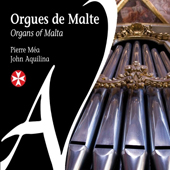
COLLECTIONS

Oratory's historic Organ of St. John's Co-Cathedral, Valletta (1579)
- Francesco Correa de Arauxo - Tres glosas el Canto Llano de la Immaculada Concepcion
- Anonymous Spanish - Cancion "Je vous ..."
- Sebastian Aguilera de Heredia - Salve de Lleno
- Sebastian Aguilera de Heredia - Salve de 1. tono por De la sol ré
- Juan Cabanilles - Pasacalle 1. tono
- Girolamo Frescobaldi - Canzon dopo l'Epistola
- Luzzascho Luzzaschi - Toccata del quarto tono
- Ercole Pasquini - Canzone Francese
- Girolamo Cavazzoni - Christe Redemptor Omnium
Historic Organ of St. Paul's Metropolitan Cathedral, Mdina (1774)
- Anonymous English - My Lady careys dompe
- Anonymous English - Upon la mi ré
- Maurice Greene - Voluntary in B flat
- Giuseppe Paolucci - Toccata per l'Elevazione
- Domenico Zipoli - Canzona in Fa
- Domenico Zipoli - Canzona in sol
Great Organ of St. John's Co-Cathedral, Valletta (1960)
- Dietrich Buxtehude - Praeludium in D dur BuxWV 139
- Johann Sebastian Bach - Nun komm der Heiden Heiland BWV 659
- Claude-Bénigne Balbastre - Noël "Joseph est bien Marié"
- Jean-Francois Dandrieu - Noël "Or nous dites Marie"
- Johann Sebastian Bach - Pièce d'orgue in G dur BWV 572
An invaluable historical as well as musical record, including a few firsts to boot. It seems that the historical organs of St. Paul and St. John's Oratory, where many knights
are buried, have never been recorded before. And I believe that some of the works on this CD are also enjoying their first recording. In fact, one of the highlights on this
disc has never, as far as I know, been recorded before. The Toccata per l'Elevazione by Giuseppe Paolucci (1726-1776)
is the kind of piece that always brings out an organ's beautifuly soft and warm tones, and organist John Aquilina has chosen the perfect combination
of stops on this instrument to achieve just that, which also reinforces the pieces inner harmonic beauty.
Other fine moments on this new recording include the simple chant inspired piece by Francesco Correa de Arauxo (1584-1654) in which you can actually
hear the air passing through the pipes and the mechanical action of the valves as they open and close. The Girolamo Frescobaldi (1583-1643) early
effort at counterpoint. The joyful little flute stops that organist Pierre Méa deploys for the My Lady careys dompe. And
the perfectly paced and voiced interpretation of the Nun komm der Heiden Heiland BWV 659 by Johann Sebastian Bach.
You will also have fun following all the different twists that Claude-Bénigne Balbastre (1727-1799) inflicts on his Noël "Joseph est bien Marié".
The sound recording itself was engineered by the highly respected musician and producer Jean-Yves Labat de Rossi. It captures these exceptional
instruments and the spatial acoustics around them very well. Ad Vitam records has the exclusive use of a proprietary technology called HDRS (High
Definition Recording System). I recommend that you visit the Ad Vitam website for an interesting background on their recording philosophy.
Jean-Yves Duperron - October 2011